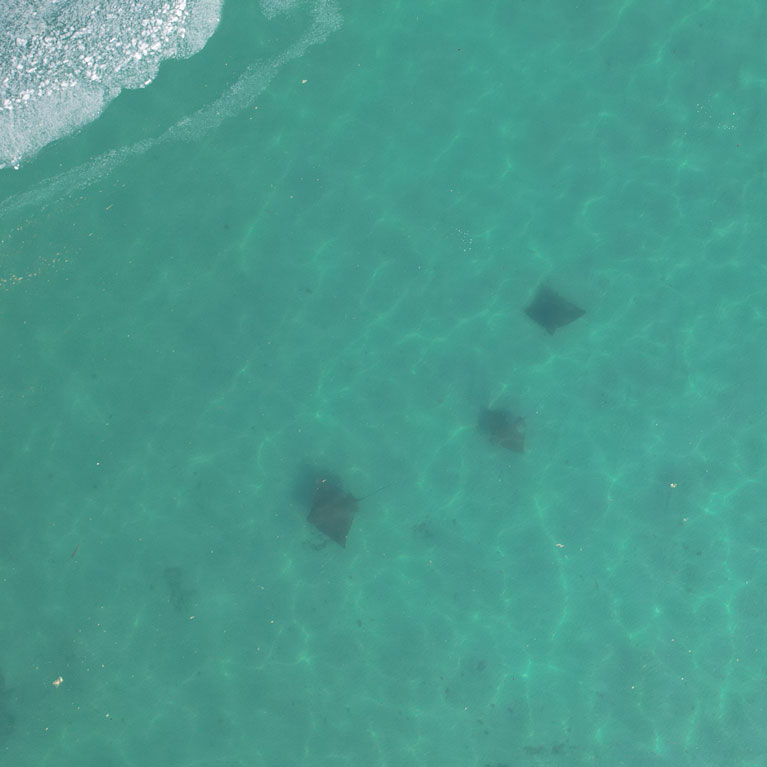An eye on the eagle rays of northern Chile
Ana will be launching unmanned aerial vehicles (UAVs) to detect Chilean eagle rays in the sandy shallows along the Atacama Desert coast. She wants to know their size and how many there are, how and where they move, and whether these patterns differ between seasons. Information about these poorly understood rays is critical to answer questions about their management in Mejillones Bay. Ana will also find out whether the children from the area know anything about the ecology of these rays and whether fishers would be willing to implement release strategies to reduce bycatch.
I am a marine scientist and my passion has been marine wildlife for as long as I can remember. I grew up on the coast of south-eastern Spain in a small town near the Mar Menor saline lagoon in the Mediterranean Sea. My parents used to take me to the beach and I remember being surrounded by seahorses in the shallow water of Mar Menor when I was three years old. Since then I have seen how the Mar Menor marine ecosystem has collapsed and now there are no more seahorses in the lagoon. I decided to become...
Counting eagle rays from the sky of Atacama Desert coast
The key objective of this study is to estimate the abundance, seasonality, distribution, size and habitat use of the Chilean eagle ray in Mejillones Bay by using an unmanned aerial vehicle and to institute a conservation-awareness strategy among local fishing communities.
This project will provide new information about the abundance and distribution of Chilean eagle rays in northern Chile that will be useful for the National Fisheries and Aquaculture Service to propose management strategies for the protection of Chilean eagle rays. It is important for the people of Mejillones in that it enables them to learn about this ray species that shares their shallow coastal waters.
The Chilean eagle ray Myliobatis chilensis is a batoid species that occurs along the south-eastern Pacific coast from San José in Peru to Valdivia in Chile, from shallow water to a depth of 100 metres (330 feet). It is listed as Vulnerable on the IUCN Red List of Threatened Species, with a decreasing population trend of 30–49% in the past 45 years due to being caught incidentally in Chilean and Peruvian fisheries. Moreover, there are concerns that Chilean landings of this species are severely underestimated. No population estimates are available to propose conservation or recovery plans for it in the south-eastern Pacific. In this project we will gather new information about the ecology of the Chilean eagle ray in northern Chile. Using a drone, we will determine its abundance, residency patterns and habitat use and by means of aerial laser photogrammetry we will determine the size of these eagle rays in the shallow waters of Mejillones Bay, providing new information about this poorly known species. In addition, since Chilean eagle rays are consumed locally in Chilean and Peruvian fishing communities, programmes such as Mision Raya Perú and Prodelphinus in Peru have started a campaign and published a handbook on how to release live rays in gill nets in order to raise conservation awareness among local fishermen. They have conducted workshops that provide information about the importance of rays in the Humboldt Current system and the need to protect them to increase the size of their populations. However, in northern Chile there are no such programmes or studies and fishermen have no information about the importance of Chilean eagle rays along our coast. We therefore aim to conduct workshops and provide infographics to promote conservation awareness.
The general aim of this project is to provide new information about the abundance, distribution, residency patterns, habitat use and size of Chilean eagle rays in the shallow sandy waters off the Atacama Desert coast. Our objectives will be to:
- Obtain valuable images of Chilean eagle rays in shallow water by using a drone;
- Estimate the size of individuals by means of aerial laser photogrammetry;
- Establish whether Chilean eagle rays are present all year in Mejillones Bay or show seasonality, and whether hot water from the thermo-electric industries affect the distribution patterns and seasonality of the eagle rays in the bay;
- Establish whether children at Mejillones schools know the biology and ecology of the Chilean eagle ray and whether fishermen are willing to protect the species by releasing rays caught incidentally.
Overall, this research is important to provide information about the population trends of this Vulnerable and poorly known species in northern Chile and to propose strategies for its recovery.


